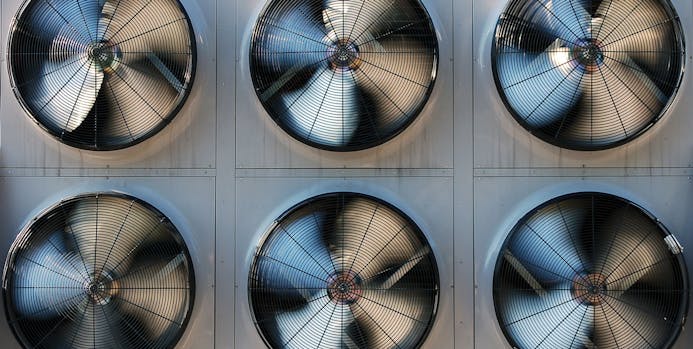Inverter maintenance for aircon engineers
2020-09-30
5 min read
Inverter driven air conditioning is more energy-efficient, cheaper to operate and more profitable to install than its non-inverter driven equivalent. In this guide, we explain how HVAC engineers can maintain the inverters in their customer’s aircon units.
Why isn’t all aircon inverter-driven?
We all know that inverter-driven aircon is better than its non-inverter driven cousins. It can provide heating as well as cooling and the lifetime cost of use is less for the customer — because their energy bills stay low. The cost of installation is also higher because it is a more complex job, so it works out better for the contractor. It’s a win-win.
The research firm Technavio even lists it as one of the key technologies driving growth in the HVAC market in its annual reports every year. So, the only question is, why isn’t every installation an inverter-driven unit, instead of the traditional single stage or dual stage models?
Cost is a factor, but when contractors contact EU Automation to buy replacement motors and inverters, and other automation parts, for the units they maintain, they have given us another reason: maintenance.
As HVAC engineers, we are not necessarily specialists in power electronics, and this makes inverter maintenance daunting. Microcontrollers and IGBTs (Insulated Gate Bipolar Transistors) are not beyond us by any means, but they can be intimidating. Personally, I would back an electrical or heating engineer over an electronics specialist in a problem-solving contest all day long; but that doesn’t solve the problem at hand.
Furthermore, while we are experts in air conditioning brands, and know our Daikins and Grees from our Mitsubishis and Fujitsus, we don’t necessarily have contacts at the inverter manufacturers. Amtech, Danfoss, Vacon and Yaskawa are all names we know, but the local dealer for any of them is probably not in your phone book. This is especially true if the unit you need is from a first-generation inverter-driven aircon unit and well over a decade old.
Maintenance techniques
While inverter maintenance can be daunting, it isn’t difficult. The tools you will need most often are nothing more than a rag and a spanner, while the more esoteric kit is stuff you probably carry anyway, a laptop, vacuum and a Fluke meter.
Before you start, remember that while we tend to refer to an inverter as an inverter, the manufacturers themselves, and many of the sources of information online, often refer to them as VSDs (Variable Speed Drives), VFDs (Variable Frequency Drives) or just plain old drives.
As a result, when you are searching online for a video to explain something, it’s worth using all three of those terms, alongside the inverter manufacturer’s name and the problem to make sure you get the right result.
When you do move on to maintenance, step one is simple; make sure that the unit is free of dust. This is as easy as vacuuming the heatsink with an ESD (Electrostatic Discharge) vacuum cleaner when you perform routine maintenance or investigate a problem.
While you are checking for a build-up of dust and daily grime, check the filters. They will probably have to be replaced during annual maintenance, but high use might mean they need to be replaced more often.
The control panel itself should be well ventilated and free of dust as well, if it isn’t it can overheat, which is the number one cause of inverter damage and the most common reason contractors contact us for replacement units.
Before you put your vacuum and duster away, you should make sure that the inverter unit’s location is clean and as sheltered from the elements as possible. Because it’s normally situated on a roof, it’s not going to be perfect, but the units are designed to take a limited battering. That doesn’t mean it’s okay for them to be covered in leaves, surrounded by rubbish or immediately beneath the guttering outlet though!

Get out the spanner
Once you’ve finished these steps, you are done with dusting, for now, it’s time to get out your screwdriver and your spanner.
Step one is to make sure the fans on the inverter are operating normally, without noise and with nothing blocking their rotation. The fan keeps the internal components running effectively, just as it does on PC, and if its function is impaired the capacitors will overheat and the inverter will fail.
The next job is to grab your spanner and make sure the power terminals are on tight. Loose connections cause arcing, overheating and even melting of components and are easily checked during any kind of maintenance and repair.
While we are still in the realms of the work your apprentice can do with their eyes close, you should also make sure that the inverter’s removable LCD control pad is stored sensibly and not continually attached to the drive. If it remains attached, there is a chance the display will stay on permanently, which means that when you need it to diagnose a problem, it will probably already be burnt out.
Break out the laptop
When you install or maintain an inverter on an air conditioning system, it is a sensible precaution to back up the drive parameters to your laptop. It takes minutes and is normally done by using the removable LCD control. In fact, it’s often as simple as selecting ‘PARs’ and then ‘BACKUP’ from the menu. If you struggle, there are lots of videos on YouTube, like this one, which explains the process for each drive.
As a result, if the inverter ever does need replacing, you can whip out your backed up parameters and order a new or refurbished one easily, before reloading the parameters to the replacement and getting up and running in no time. Your customers will think you are a power electronics genius, as well as a HVAC expert, and they will be loyal for life; especially if you save them on a hot day!
If you follow these simple measures, you will find that the inverters in your customer’s air conditioning units last much longer and no motors will have to run the equivalent of a cross country, thanks to a lack of inverter control.



